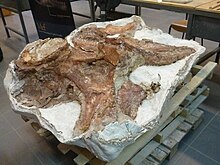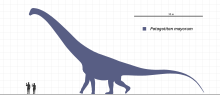User:Saurophaganax22/sandbox
| Patagotitan | |
|---|---|
| Reconstructed skeleton and fossils on display at the American Museum of Natural History, New York | |
| Scientific classification | |
| Domain: | Eukaryota |
| Kingdom: | Animalia |
| Phylum: | Chordata |
| Clade: | Dinosauria |
| Clade: | Saurischia |
| Clade: | †Sauropodomorpha |
| Clade: | †Sauropoda |
| Clade: | †Macronaria |
| Clade: | †Titanosauria |
| Clade: | †Lognkosauria |
| Genus: | †Patagotitan Carballido et al., 2017 |
| Type species | |
| Patagotitan mayorum Carballido et al., 2017
| |
Patagotitan is a genus of
Discovery

Remains of Patagotitan, a part of a lower thighbone, were initially discovered in 2008 by a farm laborer, Aurelio Hernández, in the desert near La Flecha, about 250 km (160 mi) west of Trelew. Excavation was done by palaeontologists from the Museum of Paleontology Egidio Feruglio. The lead scientists on the excavation were Jose Luis Carballido and Diego Pol, with partial funding from The Jurassic Foundation. Between January 2013 and February 2015 seven paleontological field expeditions were carried out to the La Flecha fossil site, recovering more than 200 fossils, both of sauropods and theropods (57 teeth). At least six partial skeletons, consisting of approximately 130 bones, were uncovered, making Patagotitan one of the most complete titanosaurs currently known.[1][2]
The

The
The animals found, though excavated in a single quarry, did not all die at the same time. Within the 343 centimetre thick sediment containing the fossils, three distinct but closely spaced horizons correspond to three different burial events in which young adult individuals perished during floods. The water did not transport the carcasses any further but covered them with sandstone and mudstone. The animals were about the same size, differing no more than 5% in length. As far as can be ascertained, all bones discovered belong to the same species and are thus part of a monospecific assemblage.[1]
Description

P. mayorum has been estimated to have been 37 m (121 ft) long

The researchers who described the animal stated:
Given the size of these bones, which surpass any of the previously known giant animals, the new dinosaur is the largest animal known that walked on Earth.
Upon its initial discovery, science writer Brian Switek cautioned that it was too early to calculate the exact size of the dinosaur.[9] Switek had said it may be revised to 33.5 m (110 ft) and 45.4 tonnes (50.0 tons).[9]
Distinguishing traits
The authors indicated nine distinguishing traits of Patagotitan. The first three back vertebra have a lamina prezygodiapophysealis, a ridge running between the front articular process and the side process, that is vertical because the former process is situated considerably higher than the latter process. With the first two back vertebrae, the ridge running to below from the side front of the
Phylogeny
In 2017, Patagotitan was placed, within the
Paleoecology
Patagotitan lived during the
Possible Contemporaries
- Period. It is among the largest known dinosaurs.[13]
- Cretaceous Period in South America.These fossils were discovered in the Candeleros Formation, dating to the Cenomanian stage of the Late Cretaceous period, about 99.6 to 97 million years ago.[14]
- theropod dinosaur from the Cretaceous of Argentina.Four skeletons were found in 2004 in sandstone in Patagonia, Argentina during an excavation led by Sebastián Apesteguia and Peter Makovicky. Buitreraptor is from the early Late Cretaceous Candeleros Formation, dating to the Cenomanian-Turonian, about 94 million years ago.[15]
- sauropod dinosaur of the superfamily Diplodocoidea. It was found in the Rayoso Formation, in Patagonia, Argentina and lived about 99 million years ago (during the Early Cretaceous). The type species is R. agrionensis, named by Argentinian paleontologist José Bonaparte in 1996.[16]
- sauropod dinosaur from the Lower Cretaceous of northwestern Patagonia. Limaysaurus was uncovered between 1995 and 2002 from the Puesto Quiroga Member of the Lohan Cura Formation at Cerro Aguada del León in the south-central part of Neuquén Province, Patagonia, Argentina.[17]
Explanation
The presence of predator to take down prey is a well understood natural mechanism to prevent population explosion of herbivores. It follows that large prey will be accompanied by a proportionately large predator capable of taking it down.
The scattered remains of Argentinosaurus are "associated" with those of the 10-ton carnivore Giganotosaurus, meaning these two dinosaurs shared the same territory in middle Cretaceous South America. While there's no way even a desperately hungry Giganotosaurus could have taken down a full-grown Argentinosaurus all by itself, it's possible that these large theropods hunted in packs, thus leveling the odds.[18] It is a reasonable deduction to state that Patagotitan may have shared a similar relationship with Giganotosaurus, given their proximity in time period and habitat. Up to 90% of predator-prey links involve a larger predator eating a smaller prey. [19] This strengthens the notion that Giganotosaurus fed on juvenile Patagotitans.
Lastly, the above mentioned contemporaries gave been selected purely based on proximity to Patagotitan in terms of geography and time period. It is important to note that no formal research has yet been released/conducted in relation to Patagotitan on the above mentioned data. Hence, the data is at worst pure conjecture and at best a reasonable case of deductive reasoning.
References
- ^ .
- ^ .
- ^ Giant dinosaur slims down a bit. BBC News Science & Environment. [1]
- ^ a b Morgan, James. "BBC News - 'Biggest dinosaur ever' discovered". Bbc.com. Retrieved 17 May 2014.
- ^ Giant dinosaur slims down a bit. BBC News Science & Environment. [2]
- .
- PMID 24348896.)
{{cite journal}}: CS1 maint: unflagged free DOI (link - PMID 26777391.
- ^ doi:10.1186/1741-7007-10-60. Retrieved 11 June 2016.)
{{cite web}}: CS1 maint: unflagged free DOI (link - ^ Gillian Mohney via Good Morning America. "Researchers Discover Fossils of Largest Dino Believed to Ever Walk the Earth - ABC News". Abcnews.go.com. Retrieved 17 May 2014.
- ^ "Argentine fossil biggest dinosaur ever: scientists". NY Daily News. Retrieved 17 May 2014.
- ^ a b "Giganotosaurus". Wikipedia. 26 October 2017.
- ^ "Argentinosaurus". Wikipedia. 26 October 2017.
- ^ "Andesaurus". Wikipedia. 22 October 2017.
- ^ "Buitreraptor". Wikipedia. 25 August 2017.
- ^ "Rayososaurus". Wikipedia. 22 October 2017.
- ^ "Limaysaurus". Wikipedia. 16 October 2017.
- ^ "Meet Argentinosaurus, the World's Biggest Dinosaur". ThoughtCo. Retrieved 1 November 2017.
- ^ Cohen, Joel E.; et al. (1993). "Body sizes of animal predators and animal prey in food webs" (PDF). Journal of Animal Ecology: 62, 67–78 – via http://lab.rockefeller.edu.
{{cite journal}}: Explicit use of et al. in:|last=(help); External link in|via=|title=at position 55 (help)
